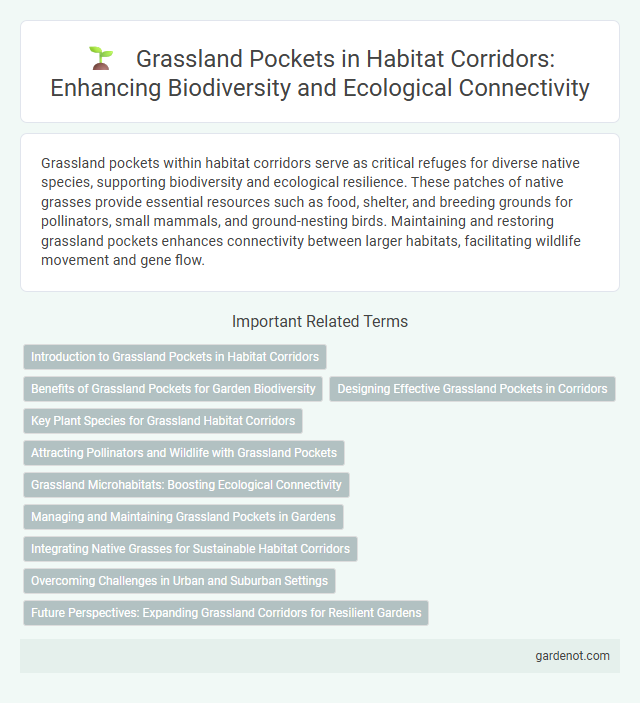Grassland pockets within habitat corridors serve as critical refuges for diverse native species, supporting biodiversity and ecological resilience. These patches of native grasses provide essential resources such as food, shelter, and breeding grounds for pollinators, small mammals, and ground-nesting birds. Maintaining and restoring grassland pockets enhances connectivity between larger habitats, facilitating wildlife movement and gene flow.
Introduction to Grassland Pockets in Habitat Corridors
Grassland pockets within habitat corridors serve as critical refuges for native flora and fauna, maintaining biodiversity and ecological connectivity across fragmented landscapes. These microhabitats provide essential resources such as food, shelter, and breeding grounds for pollinators, small mammals, and ground-nesting birds. Integrating grassland pockets into habitat corridors enhances landscape resilience by promoting gene flow and supporting ecosystem services like soil stabilization and carbon sequestration.
Benefits of Grassland Pockets for Garden Biodiversity
Grassland pockets enhance garden biodiversity by providing essential habitats for pollinators, such as bees and butterflies, which improve plant reproduction and ecosystem resilience. These pockets support native plant species that offer food and shelter for various insects and small wildlife, promoting ecological balance. Incorporating grassland pockets in urban gardens increases species richness and fosters natural pest control, contributing to healthier garden ecosystems.
Designing Effective Grassland Pockets in Corridors
Designing effective grassland pockets in habitat corridors requires selecting native grasses and wildflowers that support local pollinators and wildlife, enhancing biodiversity. Optimal placement involves creating patches with varied plant heights and structures to provide shelter and foraging opportunities within the corridor. Incorporating soil quality improvements and managing invasive species ensures the long-term viability and ecological function of these grassland pockets.
Key Plant Species for Grassland Habitat Corridors
Key plant species essential for grassland pocket habitat corridors include Andropogon gerardii (big bluestem), Schizachyrium scoparium (little bluestem), and Bouteloua gracilis (blue grama), which provide critical food and shelter for native wildlife. These native grasses maintain soil stability, enhance biodiversity, and facilitate movement of pollinators across fragmented landscapes. Incorporating forbs like Echinacea purpurea and Liatris punctata further supports diverse insect populations vital to the ecological resilience of grassland corridors.
Attracting Pollinators and Wildlife with Grassland Pockets
Grassland pockets serve as vital habitat corridors that attract diverse pollinators such as bees, butterflies, and hummingbirds by providing native flowering plants rich in nectar and pollen. These pockets support wildlife by offering food, shelter, and breeding grounds, enhancing biodiversity within fragmented landscapes. Incorporating grassland pockets into urban and rural areas promotes ecological connectivity and strengthens local ecosystems.
Grassland Microhabitats: Boosting Ecological Connectivity
Grassland pockets serve as essential microhabitats within larger landscapes, providing critical stepping stones that enhance ecological connectivity for diverse species. These fragmented grassland patches support pollinators, small mammals, and ground-nesting birds by offering shelter, food resources, and breeding sites. Maintaining and restoring these microhabitats facilitates gene flow, species movement, and ecosystem resilience in agricultural and urban matrices.
Managing and Maintaining Grassland Pockets in Gardens
Effective management of grassland pockets in gardens involves regular monitoring of native plant species to promote biodiversity and prevent invasive species from overwhelming the space. Maintaining soil health through organic mulching and minimal disturbance supports robust plant growth and attracts pollinators essential for ecosystem balance. Periodic mowing outside nesting seasons helps control woody plant encroachment while preserving the habitat structure vital for small mammals and insects.
Integrating Native Grasses for Sustainable Habitat Corridors
Integrating native grasses in grassland pockets enhances habitat corridors by improving soil health and providing essential food and shelter for local wildlife. Native grasses such as big bluestem, switchgrass, and little bluestem promote biodiversity and support pollinators, contributing to ecosystem resilience. These grasses also facilitate natural water filtration and carbon sequestration, which are critical for sustainable habitat restoration and connectivity.
Overcoming Challenges in Urban and Suburban Settings
Grassland pockets serve as vital habitat corridors by connecting fragmented ecosystems in urban and suburban areas, allowing wildlife to safely traverse and access essential resources. Overcoming challenges such as habitat fragmentation, pollution, and human disturbance involves strategic planning, native plant restoration, and community engagement to enhance biodiversity resilience. Implementing green infrastructure and controlled land use policies promotes the functionality of these corridors, supporting species persistence amid expanding development.
Future Perspectives: Expanding Grassland Corridors for Resilient Gardens
Expanding grassland corridors involves strategic planting of native grasses and wildflowers to connect isolated garden patches, enhancing biodiversity and ecosystem resilience. Integrating these corridors into urban and suburban landscapes promotes pollinator pathways and supports wildlife movement. Long-term monitoring and adaptive management ensure these corridors respond effectively to environmental changes and urban development pressures.
Grassland pocket Infographic

 gardenot.com
gardenot.com